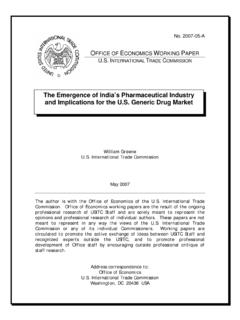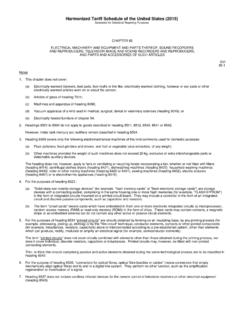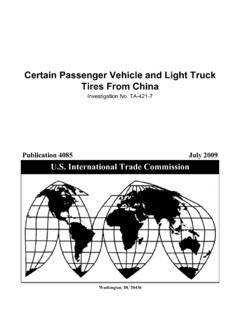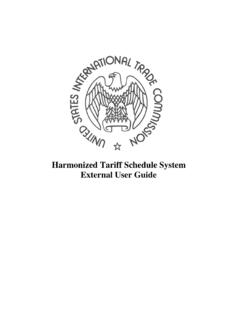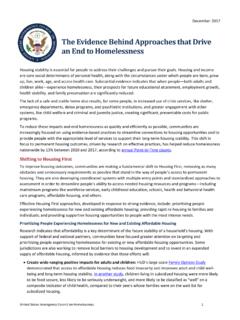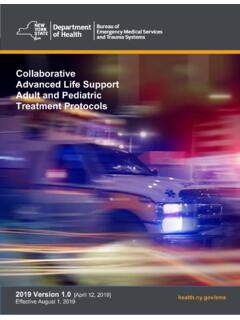Transcription of The Post-9/11 Global Framework for Cargo Security
1 The Post-9/11 Global Web version: Framework for Cargo March 2008. Security Authors: Joann Peterson and Alan Treat1. Abstract This paper reviews changes in Global Cargo Security policies following September 11, 2001. The events of 9/11 led to the establishment of new protocols for tracking and screening Cargo both in the United States and in foreign countries. These protocols have been incorporated into international frameworks such as those under the World Customs Organization (WCO), and in country-specific programs such as the Container Security Intiative (CSI) and the Customs-Trade Partnership Against Terrorism (C- TPAT) administered by the United States. In addition, a host of foreign countries, including Australia, Canada, Sweden and New Zealand have introduced new Cargo Security programs following 9/11 or have strengthened previously existing programs.
2 Many of these countries aim to harmonize their Cargo Security standards with those of the United States. Although substantial progress has been made in the development of Post-9/11 Cargo Security programs, some have expressed concern regarding the programs'. efficacy, their costs to business, and their effects on cross-border trade. At present, Post-9/11 Cargo Security programs continue to be refined, which may ultimately lead to changes in the direction and implementation of these programs. 1. Joann Peterson and Alan Treat are International Trade Analysts in the Office of Industries. The views presented in this article are solely those of the authors, and do not necessarily represent the opinions of the US. International Trade Commission or of any of its Commissioners. 1. Introduction This article surveys changes in Cargo Security policies following the terrorist attacks of September 11, 2001.
3 The events of 9/11 led the United States and its trade partners to re-assess and strengthen the Global Cargo Security regime, resulting in new protocols for tracking, screening, and inspecting containerized imports and exports (Schmitz 2007).2 These protocols have entered international frameworks such as those under the World Customs Organization (WCO), and have led to two new prominent programs; the Container Security Initiative (CSI) and the Customs-Trade Partnership Against Terrorism (C-TPAT). Several trade partners have either established programs similar to those of the United States or participated in the mutual recognition of these programs. Despite progress in the development and implementation of Post-9/11 Cargo Security programs, however, concerns remain regarding their efficacy, their costs to business, and their effects on cross-border trade.
4 For example, while the primary goal of Post-9/11 programs is to prevent the cross-border movement of terrorist-related weapons, some have found that nonuniform Security procedures among C-TPAT members and inadequate screening equipment at certain CSI ports may compromise this objective (GAO 2005). Separately, it is unclear whether the benefits of participation in Post-9/11 Cargo Security programs outweigh their costs to participants. In particular, a 2007. study conducted by the University of Virginia found that whereas the annual costs to importers of participation in C-TPAT were more than $30,000, the benefits of such participation, including increased supply chain Security and fewer customs inspections, had not yet been fully realized (CBP 2007b). Finally, a recent Canadian study found that while Post-9/11 Cargo Security programs have had no measurable impact on the volume of cross-border trade between the United States and Canada, such programs have resulted in increased border delays and therefore higher costs for firms engaged in Canada trade (CBP 2007b).
5 2. In general, the objective of Cargo Security measures is to prevent the cross-border shipment of dangerous or illicit goods such as weapons of mass destruction (WMD), drugs, chemicals intended for destructive use, counterfeit or undeclared merchandise, firearms, currency, and hazardous materials. 2. Following a discussion of international agreements that address Cargo Security , this article will review and foreign-country-based Cargo Security programs developed after 9 The article will then outline the primary challenges and concerns of current programs, as plans to expand the Global Framework for Cargo Security move forward. International Agreements on Cargo Security The events of 9/11 precipitated a change in Cargo Security measures at national borders. Prior to 9/11, customs authorities were responsible primarily for clearing imported goods after such goods arrived at the border.
6 They did so through the review of entry documentation accompanying such goods at the time of importation and, if necessary, their physical inspection. In contrast, the Cargo Security programs developed after 9/11 emphasize preshipment examination of exports. In particular, these programs require that exporters provide customs documentation in advance of their shipment of goods to the importing country. Such advanced documentation assists customs authorities employing sophisticated and multilayered risk assessment techniques to determine whether to admit goods at the border or to hold them for further Although advance information requirements and mandatory screening procedures can disrupt the flow of cross-border trade, recent international conventions aim, for example, to harmonize customs practices across countries and to require that individual customs administrations employ efficient, technologically advanced, and unburdensome procedures for inspecting and clearing Cargo (De Wulf and Sokol 2005, xv).
7 After the events of September 11, 2001, the WCO ratified the revised Kyoto Convention on the Simplification and Harmonization of Customs Procedures and introduced a new set of protocols for Cargo Security called the Framework of Standards to Secure and Facilitate Trade (SAFE) (WCO 2006).5 The objective 3. For a brief comparison of the Cargo Security programs discussed in the following pages, please refer to the appendix at the end of this article. 4. In August 2007, President Bush signed the 9/11 Commission Recommendations Act, which requires that, by 2012, all containerized Cargo must be scanned by X- ray machine before entering the United States. For more information, see subsequent section on Cargo Security policies. Natter 2007. 5. The revised Kyoto Convention, which was drafted in June 1999 and entered into force in February 2006, is an updated version of the International Convention on the Simplification and Harmonization of Customs Procedures (Kyoto Convention) of 1974.
8 As of January 2007, 52 countries were parties to the agreement. WCO Instruments and Programmes. 3. of these documents was to address the specific Security needs of the Post-9/11 . customs environment while strengthening procedures to facilitate the movement of goods across borders (Widdowson 2007). Building upon core principles found in the 1974 Kyoto Convention, the revised convention established guidelines to facilitate cross-border trade in response to the rapid growth in the volume and pace of international commerce. Among other things, the revised convention recommended that customs administrations (1). use electronically based systems to process and clear goods; (2) employ risk management techniques in selecting goods for inspection; (3) cooperate with customs authorities from other countries; and (4) ensure that customs-related laws and regulations are transparent and made readily available to the public (WCO2005; WCO2000).
9 The revised Kyoto Convention encouraged customs authorities to advance beyond the role of gatekeeper to that of the trade facilitator (Widdowson 2007). In June 2005, the members of the WCO adopted the SAFE Framework ,6 which further expanded trade facilitation principles in the Kyoto Convention and introduced new provisions on Cargo Security in response to 9/11 (Schmitz 2007). Like the Kyoto Convention, the WCO Framework viewed customs administrations as playing a key role in facilitating trade. The Framework has two customs-centered supports: the customs-to-customs network and the customs-to-business partnership. Both support the international supply The customs-to-customs network uses automated techniques to screen high- risk Cargo ; and the customs-to-business partnership sets up procedures to precertify shippers through an authorized economic operator (an AEO.)
10 Program).8 The network and the partnerships help traders to realize the four primary concepts of the Framework : (1) the harmonization of advance Cargo information requirements across parties to the agreement; (2) the use of risk management techniques; (3) the inspection of outbound Cargo upon the request of an importing country; and (4) the establishment of new programs to expedite customs processing for commercial shippers (CRS 2006). 6. The SAFE Framework was developed jointly by customs administrations and the private sector. As of February 2007, 144 of the 171 members of the WCO were signatories to the agreement (Schmitz 2007). 7. A supply chain is defined as a network of interrelated activities including the production, transport, and storage of goods. 8. Authorized economic operator (AEO), or trusted shipper, programs are an important component of trade facilitation measures in that they permit importers, exporters, manufacturers, and transportation firms who have met precertification requirements to clear their Cargo quickly through customs.
